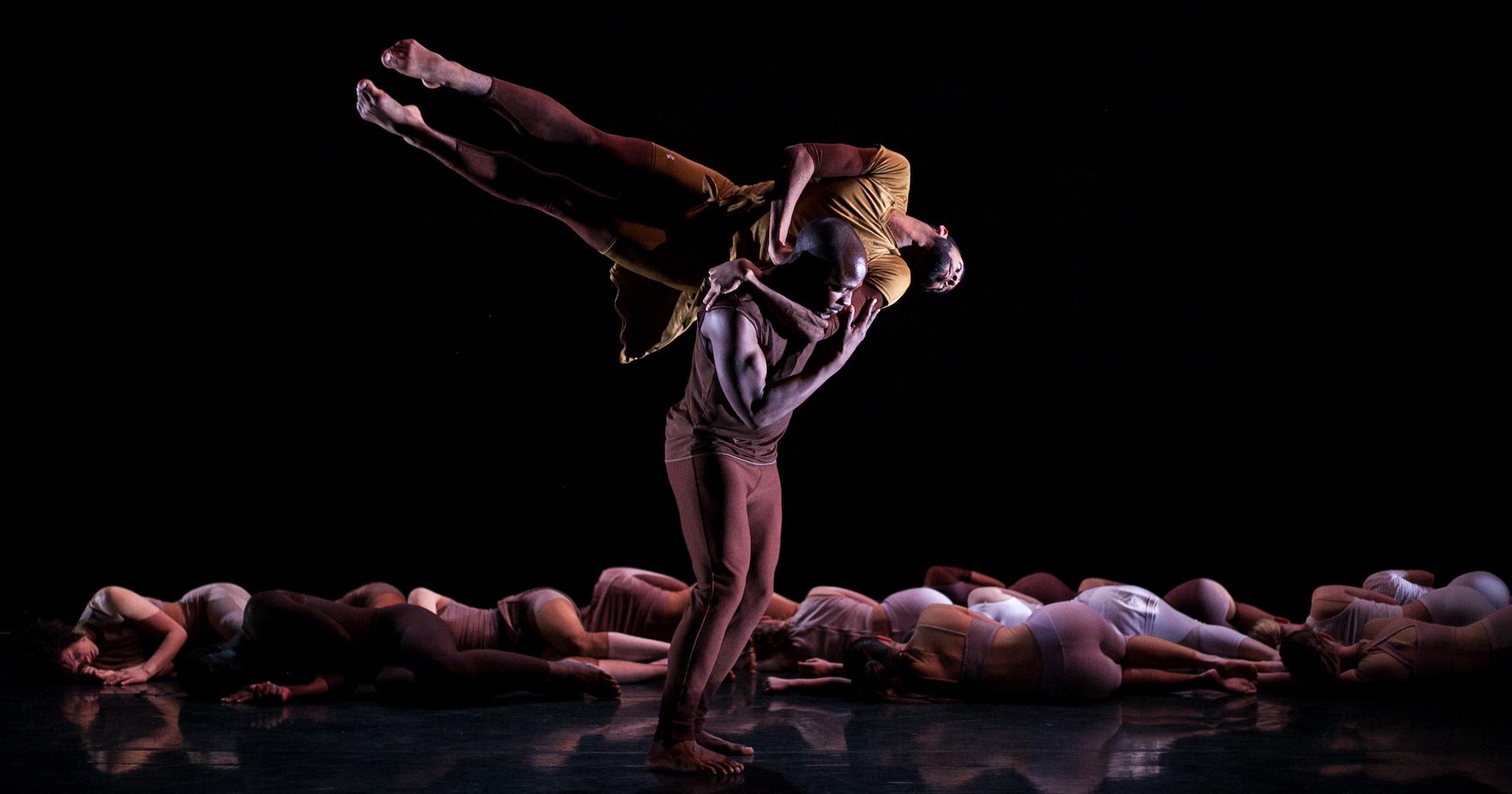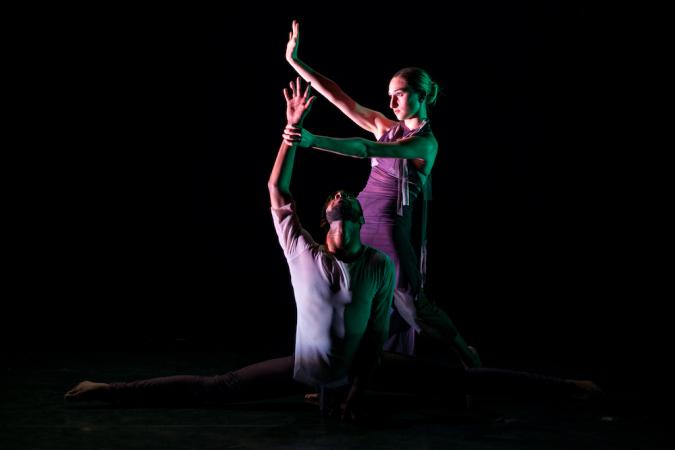
When Johnny Chatman II visited UT as a high school student, he was struck by how Associate Professor of Dance David Justin treated him during a tour of the Department of Theatre and Dance.
“He just seemed more interested in me as a person than me as a dancer, and for me, at that time, that was important,” said Chatman (B.F.A., Dance, 2016). “One of the things I remember him saying was that ‘We’re a small program, but we’re a mighty program. We’re just a big family here.’”
The theme of family emerges often among members of the Dance program. It’s a relatively small program—about 75 students pursuing a B.F.A. in Dance—and an intimate place where everyone knows your name, classmates look out for one another and offer encouragement and professors nurture students into adulthood.
“I don’t know of another dance program that is as tight, as loving, as caring as we are. I believe that stems from the faculty’s love for us and the immense diversity of dancers we have here,” said Aminah Maddox (B.F.A., Dance, 2016).

Under the leadership of Associate Professor Charles O. Anderson, the Dance program has moved in new directions to attract more diverse students and guest artists and to expand the types of dance students are exposed to in their four years here. Anderson joined the faculty in 2011 as an associate professor of African Diasporic and Contemporary Dance and became head of the program in 2015.
Anderson oversees one of the most diverse programs in the College of Fine Arts—more than half of last year’s cohort were non-white students, and the faculty also has successfully worked to recruit more male dancers to the program by taking a page out of football’s playbook and heading out on the road to scout and recruit talent.
During Anderson’s time in the program, the faculty has worked to build on the classical traditions of ballet and contemporary dance by adding coursework in tap, jazz, hip-hop and even Gaga—an Israeli style of dance—alongside training in Gyrokenesis, release technique and yoga. Professor Andrea Beckham oversees a robust Pilates program as part of the Somatics section of the curriculum that trains students in body knowledge and kinesiology.
“The professional field itself is changing. It’s not enough for students to come out of college programs being good dancers,” said Tina Curran, clinical assistant professor.
“They have to come out as good dancers, savvy about how to conduct themselves as entrepreneurs. And they have to come out savvy about how their art form is relevant and how they engage audiences.”
Curran, who joined the faculty the same year as Anderson, oversaw the launch of the Dance Studies Option in 2013 with Lyn Wiltshire, professor of Dance. Dance Studies students take the same classes as B.F.A. Dance majors—Performance Option, and they take additional courses in the College of Education to prepare them for teacher certification.
“To teach dance, one must first be skilled as a dancer,” Curran said. “At the undergraduate level, it’s important for students to fully develop themselves as dance artists. It’s really important both in our B.F.A. in Dance and for those students pursuing an education direction that first they’re artists, that they’re creators and that they’re artist citizens.”
Guest artists supplement classroom curriculum on technique, choreography, dance history and pedagogy. A-list visitors such as Sidra Bell, Manuel Vignoulle, Alex Ketley and Rennie Harris provide mentorship, set new work and offer guidance to students about how to succeed in the professional dance world. Anderson launched an emerging choreographer’s platform, the Vanguard Emerging Choreographer Residency, to attract this talent to UT.
“I think our professors really do try their hardest to make sure we’re getting all the experiences we need for post-grad life,” said Chatman. “Even in the college setting, I’ve had privilege to be in multiple works at UT, and I’ve been able to [participate in] many residencies to see how the real dance world works and how to transition my work while being a student at UT. The talent they’ve brought in past few years is astonishing, and I love seeing our program grow.”
Chatman took full advantage of the connections he made through the visiting guest artists, and he already had accepted invitations to join three dance companies when he graduated last spring—Johnnie Cruise Mercer and The RED ProjectNYC (run by Mercer), Christian Von Howard’s company, the Von Howard Project, and Charles Anderson’s own Austin-based company, dance theatre X. Chatman said he utilized his network through the program, and had time to digest and understand what it would take to support himself financially as a professional dancer. He modeled part-time while he was at UT to bring in extra income. And he took advantage of study abroad opportunities and traveled with Wiltshire to Austria, which he said gave him great perspective on what it’s like to live and work abroad as a dancer.

“The program does a very good job of showing you what your life would be like in a contract company,” Chatman said. “The rehearsal schedule is always intense. You have to learn to take care of your body physically and mentally— eating correctly, cross-training. It’s very rigorous hours, with dancing throughout the entire day, having rehearsals at night and also being a part of the in-residence company at UT. You see what it’s like to be in rehearsal process and show the product of that and perform. I think I was very prepared for that.”
Thanks to Professor Yacov Sharir, the Dance program has a long history of integrating dance with technology in performance. Sharir has been experimenting with blending the two disciplines since the 1980s, and the Department of Theatre and Dance’s strength in technology and design has been an invaluable asset to the Dance program. Students in the department are able to experiment with new ways to incorporate light, projection and movement into their choreography and performances.
“Before coming to UT, I did not have the experience of working and dancing alongside multimedia,” Maddox said. “With multimedia, there is more than just one level of entertainment going on for the eye to catch. So, as a dancer, your senses are heightened to what’s being projected, as well as what you are dancing.”
At the end of every year, the full Dance faculty sits down with each student for a one-on-one meeting to reflect on the year and to provide perspective and guidance on what the student might focus on next in his or her trajectory. The faculty guides students toward the many avenues they can pursue after graduation, whether they want to continue dancing in the Austin area, work abroad, teach, choreograph, pursue graduate school or even launch their own performance company.
“At The University of Texas at Austin, what starts here changes the world and helping our students discover they can do this through dance, watching them grow from dancers to artist citizens—that is tremendously inspiring,” Anderson said. “I want them to realize that dance is this vast and varied field with a deep and diverse history and they are now a part of it.”
Photo Credits: Top: Dancers perform in “Threshold,” choreographed by Lyn C. Wiltshire, as part of Bodies & Souls in 2016. Photo by Lawrence Peart. Middle: Johnny Chatman and Gianina Casale perform in “Eternalism,” choreographed by Gianina Casale, as part of Bodies & Souls in 2016. Photo by Lawrence Peart. Bottom: Back row, left to right, Morganne Mazeika, Kanami Nakabayashi, Summer Fiaschetti and Aminah Maddox. Front row: Professor Charles O. Anderson, Zach Khoo and D’Lonte K. Lawson. The students were selected to perform at the American College Dance Association’s national festival in the Kennedy Center in Washington, D.C. in June.

